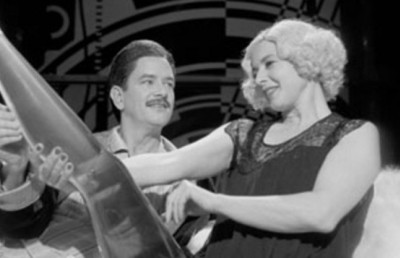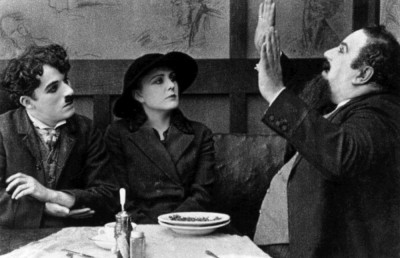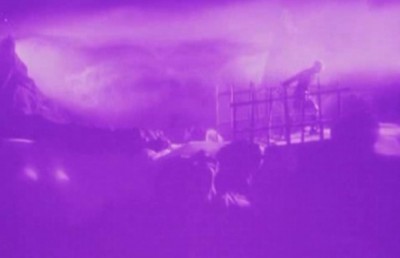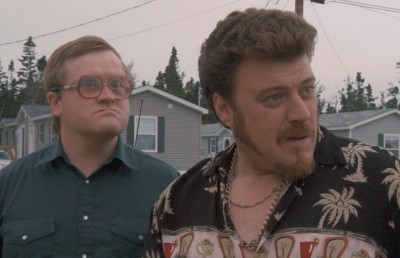Guy Maddin: My Dad is 100 Years Old
Channelling Rossellini
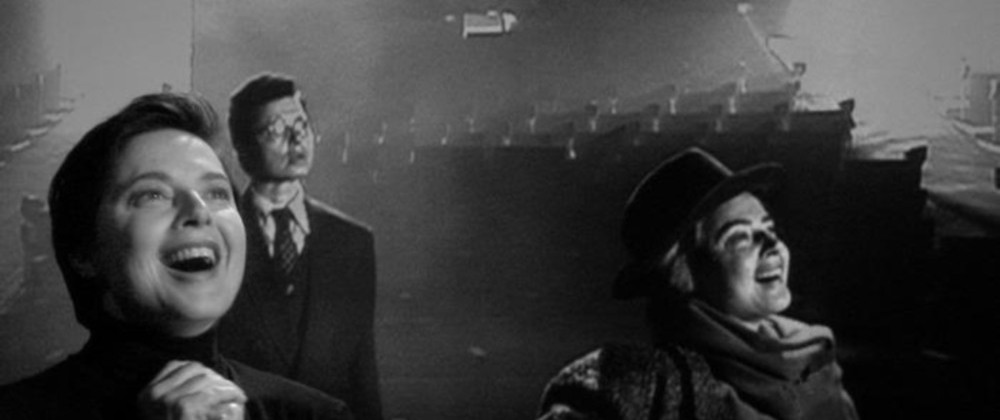
We are especially fond of Guy Maddin here at Offscreen, as our special Maddin issue of September 30, 2004 testifies. His latest film, My Dad is 100 Years Old continues to demonstrate the iconoclastic attitude which keeps Maddin from achieving conventional levels of success. Making short films which are not the medium of choice for commercial cinema is odd enough, especially for an established filmmaker. Choosing to make it on a non-commercial filmmaker who voraciously renounced commercialism, Roberto Rossellini, compounds the film’s insularity. The short format is usually intended as a vehicle for young filmmakers, but Maddin is far from that, nor in need of the exposure that a young filmmaker requires. My Dad is 100 Years Old is an odd choice for Maddin in some respects, even though it has all the stylistic earmarks of a Maddin film. It is not at the same level of formal complexity of Hearts of the World (2000) or Odilon Redon or The Eye Like a Strange Balloon Mounts Toward Infinity (1995), but still feels like an old film that has been languishing in an attic for decades. Right from the artificially antiquated credits we know we are in Maddin territory. But the film’s style, as noted, holds back in terms of formal rigor (like the rapid montages of his later films) in lieu of allowing the content and dialogue more space to breathe. Hence the film is shot in black and white, with a limited tonal range, and a reflexive attitude we have come to expect from Maddin, yet the film is more accessible than his other films, in terms of it being clearly articulated narratively –what the film is about– essentially the point of view of a single person, Isabella Rossellini, daughter of Roberto Rossellini and Ingrid Bergman. Perhaps one reason why it is less “Maddinesque” than his other films is that it is a true collaboration between Maddin and his star from The Saddest Music in the World Isabella Rossellini. Although the film is arguably more accessible than any of his other films it is still far from conventional with respect the type of film it imparts to be –a documentary account of the great Italian director Roberto Rossellini, who lived from 1906 to 1977. On the surface My Dad is 100 Years Old is a celebration of Rossellini’s centenary. As such it may be seen as a documentary, but first and foremost it is a daughter’s love paean to her father, and an extremely subjective one at that. So much so that the daughter, who also wrote the film, plays every role in the film except her father, who only appears as an oversized belly (we only see the likeness of Roberto Rossellini once in a fleeting picture). In other words, do not expect a biographical style account, or a dramatic Biography Channel-like ‘great moments’ history.
So how can one begin to describe the film? I would sum up the film as a stylized, essentially comedic distillation of Rossellini’s aesthetic belief of cinema as a Moral art, indebted to truth and sincerity, standing against a monolithic cinema of Entertainment. There is little doubt where the character of Isabella stands in this duality –with her heart on the side of her father. On the side of cinema as Entertainment and Escapism are David O. Selznick and Alfred Hitchcock, the latter seen only in silhouetted profile standing on the theatre balcony, like one of the many cameos he made in his films.
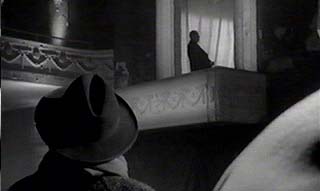
As I said, Isabella plays both of these characters, as well as Federico Fellini, who represents an auteur cinema gone wrong (for Rossellini), a ‘son’ who betrayed him for a cinema of “dreams and sex.” Remember that Fellini got his start in film working as an assistant director to Rossellini on Paisan, the middle of Rossellini’s neorealist war trilogy (Rome Open City and Germany Year Zero being the other two). When Fellini answers that Rossellini’s prudishness left out a very important aspect of life, sex, Rossellini replies that sex, as well as other commercial cinema standbys like fear and desire, are only “distractions from the truth.” Selznick acknowledges the “realistic documentary” quality of his work but sums up the experience for a paying customer by saying (in Isabella Rossellini’s high-pitched nasally voice), “his camera never moves, his films are so slow….he shows us misery and then he wants us to pay for it!” After Rossellini’s moral diatribe against the emotional manipulations of commercial cinema (fear, desire, suspense, sex) Hitchcock bellows, “For God sake Roberto, you should have been a priest not a filmmaker.” (Not without some irony on Maddin and Isabella Rossellini’s part, given how Catholic Hitchcock was!). Roberto replies, “And you should have been a magician.” Hitchcock then sums up his position with a blunt statement against Rossellini’s claim that his films were Art: “They were just slow, boring, and poorly made.” Halfway through this debate enters Charlie Chaplin, a possible mediator between Art and Entertainment. Such hopes are dashed when Chaplin, appropriately enough, ‘speaks’ in silent film intertitles as a lone wolf outsider. After hearing from both ‘camps’ Isabella chimes with her own heartfelt position, “Their [her father’s cinema] simplicity and starkness moves me profoundly.”
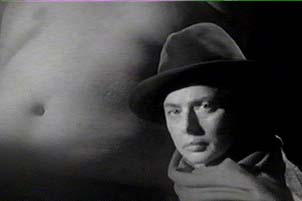
If this were a more conventional, and less intensely subjective, documentary we would get more clips from the films or interviews with relevant figures. But this is not a conventional documentary (even if that term means less now than twenty or thirty years ago). Which makes the one excerpt that we do see especially important, or at least potentially so. We see an excerpt from Rome Open City, and it is perhaps the single most defining moment of neo-realism: the scene where the “good” mother/wife Pina (Anna Magnani) is cold bloodedly shot down by the Nazis in the middle of the street as she runs after a truck carrying off her husband and other resistant fighters.
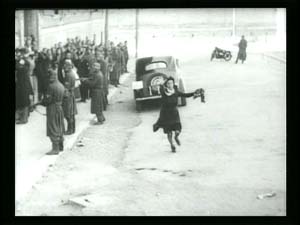
The moment is singularly defining because the death of an important and ‘heroic’ character halfway through the film sent a shockwave through cinema history, where all bets were now off in terms of narrative propriety and audience identification. Audiences were not used to “good” characters dying so early on, and with so little immediate ‘sacrificial’ justification. This may be neorealism, but the moment was also highly dramatic and highly emotional. I am stressing this moment in the film because I think there is a secondary intertextual meaning which can be made here, and that is the presence of Hitchcock. Hitchcock is said to have been the first director to bluntly kill off a central character with the death of Marion Crane (Jason Leigh) 45 or so minutes into Psycho, but Rossellini beat him to the punch by 15 years. One can nit-pick and say that the Magnani character had a smaller role and hence the audience was less emotionally involved with her than an audience would have been with Marion Crane. But the point to make here, in relation to the underlying ‘theme’ in My Dad is 100 Years Old of “Art vs. Industry,” is that both moments are highly dramatic and emotional, and that the difference in how these emotions are achieved reflects the film’s central debate, as seen by the two positions, or by one’s aesthetic taste. In other words, Rossellini would argue that the drama of Crane’s death is achieved through the grand “magician” Hitchcock’s excessive manipulation (point of view cutting, scopophilia, canted angles, chiaroscuro lighting, symbolic set design, etc.), while Hitchcock would say that the emotional weight of the death of the Magnani character is de-dramatized because it was “boring and poorly” done. The beauty, of course, is that they would both be right, and that the two positions represent the best of two possible worlds, and do not ‘prove’ the right of one ideal over the other.
The other intertextual reference one can make, although far more oblique, is to Rossellini’s Paisan. In the opening introductory sequence of My Dad is 100 Years Old, which starts with clouds, a close-up of a stomach, and flashes of light (birth?), there is a quick primitive styled animated map of a boot, unmistakably Italy, which looks like the similar animated map used to chart the Northward development of the six sections in Paisan (beginning in Sicily and ending in the Po Valley). Also, when Isabella as herself and Isabella as Ingrid Bergman discuss the great Anna Magnani, Bergman says that everyone called Magnani “La Lupa,” the wolf. Coincidentally or not, the resistance leader who is mentioned but never seen, and is reported dead in the fourth “Florence” section of Paisan, was called “Lupo” (wolf).
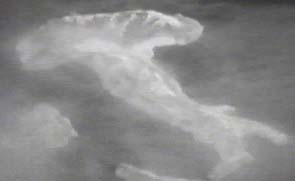
To return to the film’s “debate,” Rossellini gets in a few good jabs at his detractors, like when the Entertainment side argue that their films are “liked” by the general public, and Rossellini replies, “Like is not a measure of right.” However, the film is not intended as a serious discourse around the age-old “art vs. industry” question. Partly because the issue is not as simple as the question would presume. You would be a fool to belief that commercial filmmakers do not aspire to ‘art’ and that Artists do not aspire to be popular. But also because Maddin himself is a living contradiction with respect the issue. Maddin’s film style is not ‘populist’ or commercial in the box-office sense, but his taste and cinematic touchstones run the gamut from arcane and esoteric (German Mountain films, Carl Dreyer, silent cinema) to classical and commercial (Hollywood musical, the horror genre, the B-Movie). When I first heard of the subject of Maddin’s film –Roberto Rossellini, an Italian demigod, founding father of neorealism and champion of morally conscience cinema– I was surprised because Maddin’s previous aesthetic history did not seem to have much affinity with the philosophy of Rossellini. Maddin’s intertextual references are heavily weighted on the Germanic/expressionist side AND Hollywood classic musical and melodrama, hence this paean to one of the central antithesis’ to expressionism/Hollywood escapism, Roberto Rossellini, seems like on odd javelin for Maddin to throw. You can call Maddin a lot of things –postmodernist, iconoclast, neo-expressionist– but realist would not be one of them. And this creates an interesting double-edged tension in the film’s dichotomy between Art, represented by Roberto Rossellini, and Entertainment, represented by Federico Fellini, Hitchcock, and David O. Selznick, because Maddin as a filmmaker would, I think, be more closely aligned with the latter than the former. Which is clearly why this film is very much a collaboration between Maddin and Isabella Rossellini, and why there is a balance of sorts between the Rossellini position (father and daughter) and the Entertainment position. The meeting ground between Maddin and Isabella Rossellini is that both people see the past, whether familial or cinematic, as something that weighs heavily on the present. For Isabella Rossellini this film is an indication of just how important her father was to her and how strong his memory still is, but signifies a coming to terms of sorts. As she said in an interview conducted by Maddin, “Now, the death of my father, still by far the most significant moment in my life, feels a little bit like a fiction, and I feel like I need a new most significant moment. Maybe this is just a temporary impression, or maybe it’s a sign of health.” [1] Maddin’s own filmic past has also given great aesthetic importance to the lingering presence of death, and the dead who return, in memory or physical incarnation (beginning with his first short film, The Dead Father). This has become an aesthetic credo of sorts in the film, when Rossellini notes the importance of “dreams, fantasy, and memory.” Hence the film’s approach to the subject is not one which attempts to make sense of facts, moments, and life history, but rather what happens to facts, moments, and life history when filtered through “dreams, fantasy, and memory.” “Dreams, fantasy, and memory,” which ironically enough neatly summarizes Fellini’s aesthetics, and also a good deal of Maddin’s visual style, also hints at the description of Hollywood –the “dream factory”– and it is no coincidence that the film takes place in a cinema theatre cast in perpetual light and shadow where all but the Isabella Rossellini character –Selznick, Hitchcock, Ingrid Bergman, Fellini, Chaplin, Roberto Rossellini– are ghosts from the past.
The tensions which no doubt exist in any collaborative art comes to a reflexive head in the film’s concluding scene, where Isabella steps out of character to speak directly to Maddin/the camera, in effect getting the final word. In this final scene Isabella rests her head on her father’s oversized belly and laments the fact that her father’s films are slowly being forgotten, and that he has no disciples to follow in his footsteps. The high angle camera begins to move away from Isabella, who suddenly stops her in-character refrain and angrily addresses the off-screen camera operator: “What is that up there…why is it moving? Stop it! My father would call these camera moves immoral because they are pretentious and unnecessary.” She then instructs the camera to assume a position in the perfectly simple Rossellini framing (eye level and centered). In this final gesture Roberto Rossellini has become the surrogate director, speaking through her daughter’s voice. Isabella returns her head, child-like, to the cozy confines of her father’s belly and speaks the film’s final words, addressed to her dead father, “I don’t know if you are a genius or not, but I love you.”
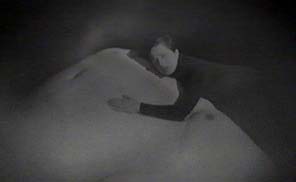
Endnotes
1 “Electra is My Middle Name, Guy Maddin Interviews Isabella Rossellini.” Introduction by Mark Peranson. Cinemascope Issue 24, Fall 2005, p. 21.



